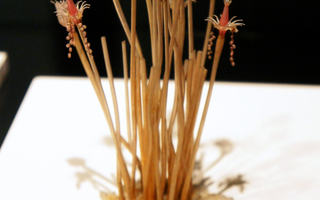Viewed annually by nearly 200,000 visitors, Harvard's world famed, collection of glass flowers is one of the University's leading public attractions. Product of a secret process and a lifetime of work on the part of two German artists, the exhibit at the Botanical Museum harbors over 800 delicately constructed models of flowers from every region of the earth.
Any damage done to the deceptively lifelike reproductions can never be repaired, for with the death of Rudolph Blaschka in 1936 passed the secret of their creation. Leopold Blaschka, founder of the remarkable process, allowed no one but his son to enter their Dresden workshop and never permitted his method to be put on paper.
The history of the Blaschka models goes back to 1886 and the founding of Harvard's Botanical Museum, now a part of Agassiz, when Professor George L. Goodale was searching for a practical means of including a collection of plant life in the new museum. Dried plants were out of the question, and wax copies were too crude. At the Comparative Zoology Museum he saw several small glass reproductions of jellyfish and conceived the idea of modelling flowers in glass. The same year he hurried to Germany to present his plans to Leopold Blaschka, creator of the marine life done in glass.
At first the German artist was unwilling to give up his profitable business in sea creatures for the new and uncertain field of flowers. Finally, however, the Blaschkas sent several samples of their work to Cambridge for a closer inspection of their possibilities. Although almost all were destroyed at the New York Customs House, enough remained to convince Professor Goodale of their excellence.
The only such exhibit in the world today, the Ware Collection of Blaschka Glass Models, as both a scientific study and an artistic curiosity, has been one of Harvard University's most valuable possessions.
Read more in News
Former CIA Official Recounts Agency's Atrocities AbroadRecommended Articles
-
Glass Flowers Show Mastery of Art, ScienceHarvard's most popular tourist attraction is not one of the hallmarks of University history--the John Harvard statue or Widener Library--but
-
Glass Flowers to Show in New YorkThe Botanical Museum will display their Blaschka Glass Flower collection outside of the University for only the second time in
-
L. Bierweiler, Past Curator, Dies At 77Louis C. Bierweiler, former curator of collections in the Botanical Museum, died Saturday at the age of 77. More than
-
 The Cinderella Story of the ‘Oaten Pipe Hydroid’
The Cinderella Story of the ‘Oaten Pipe Hydroid’ -
On Lithography, Steam, and TaxesPhilip Henry Gosse’s landmark study of sea creatures brought about a trend of displaying exotic invertebrates as glittering home decorations. Learn about the surprising visual and social appeal that dead marine fauna held for Victorian aristocrats.













